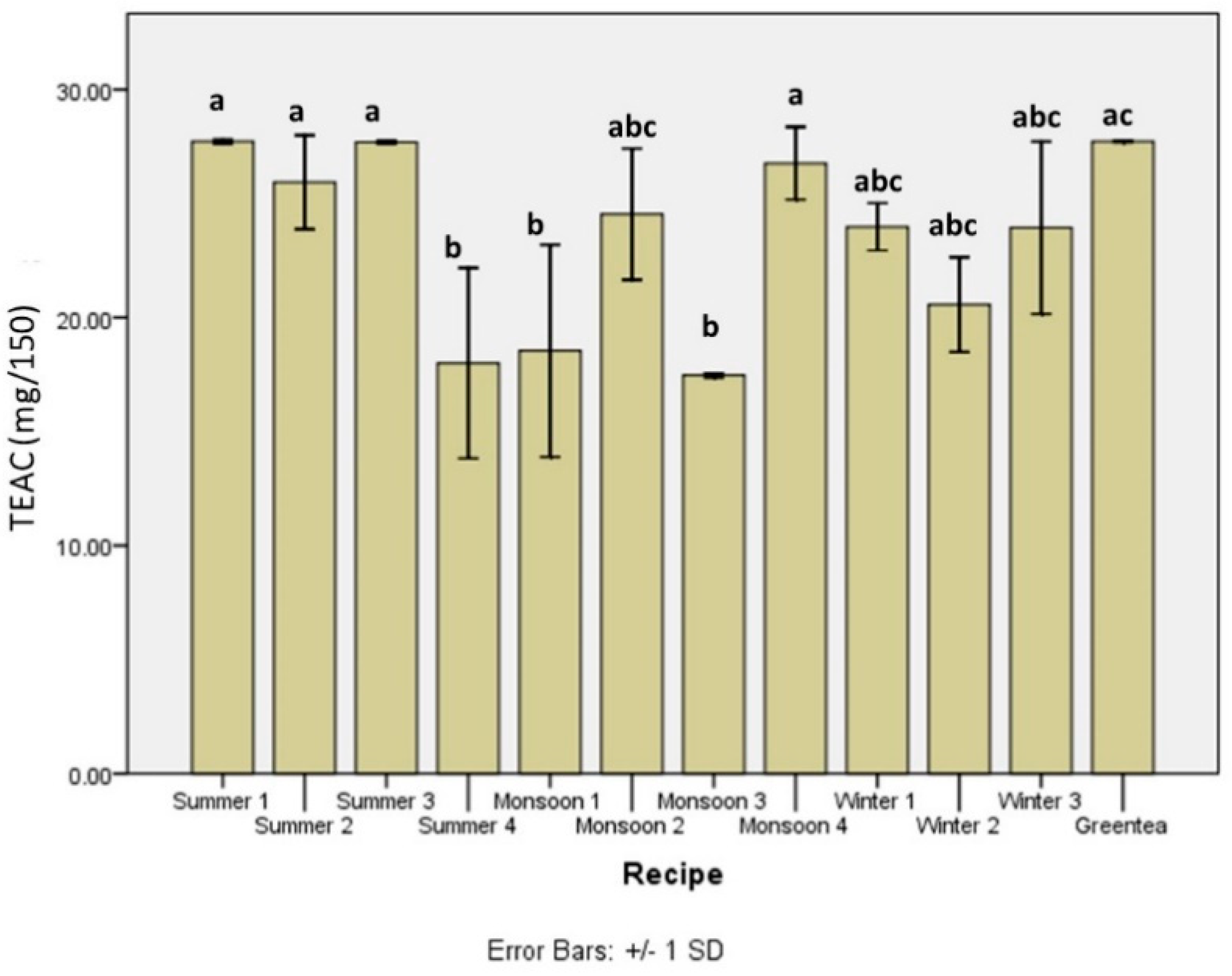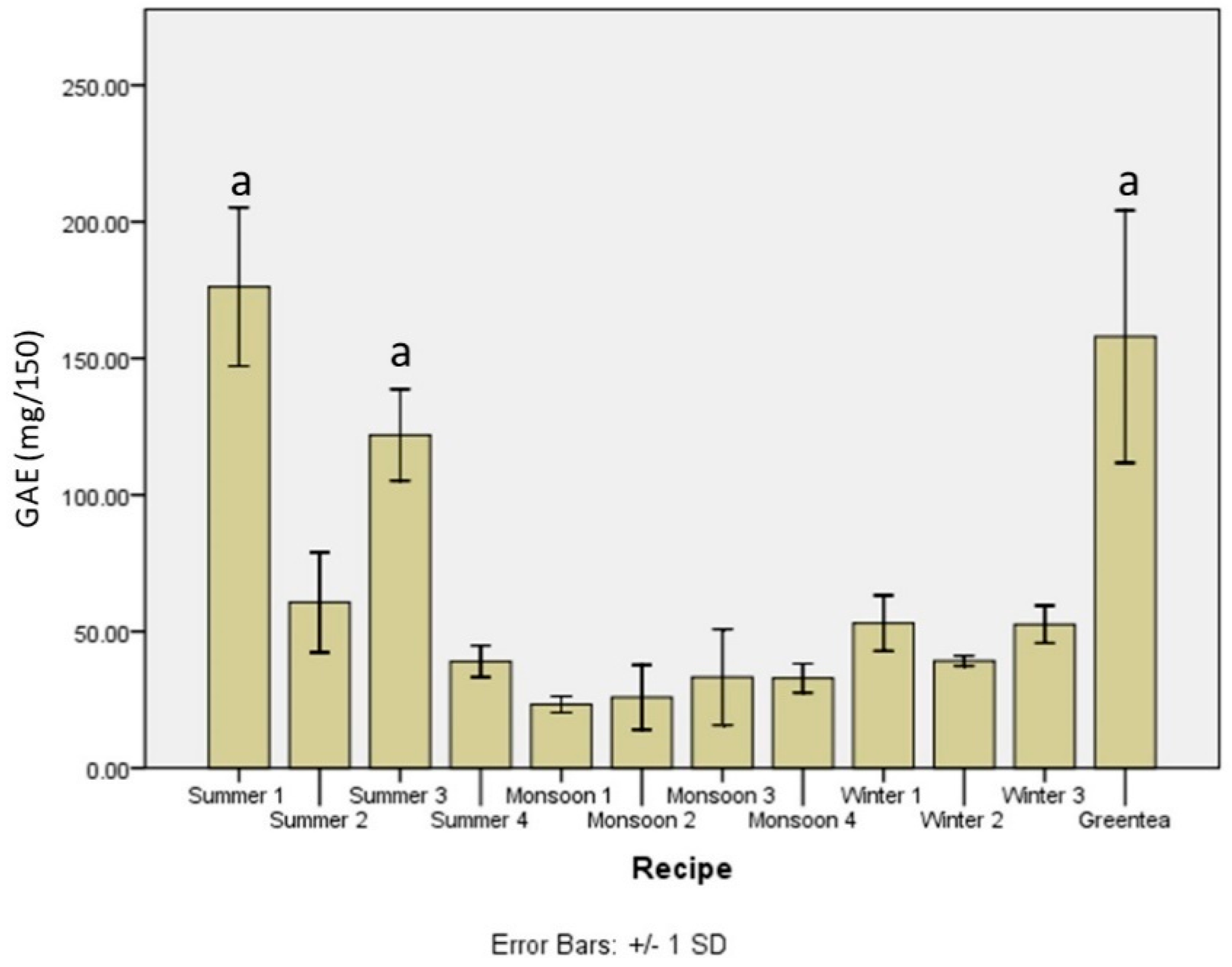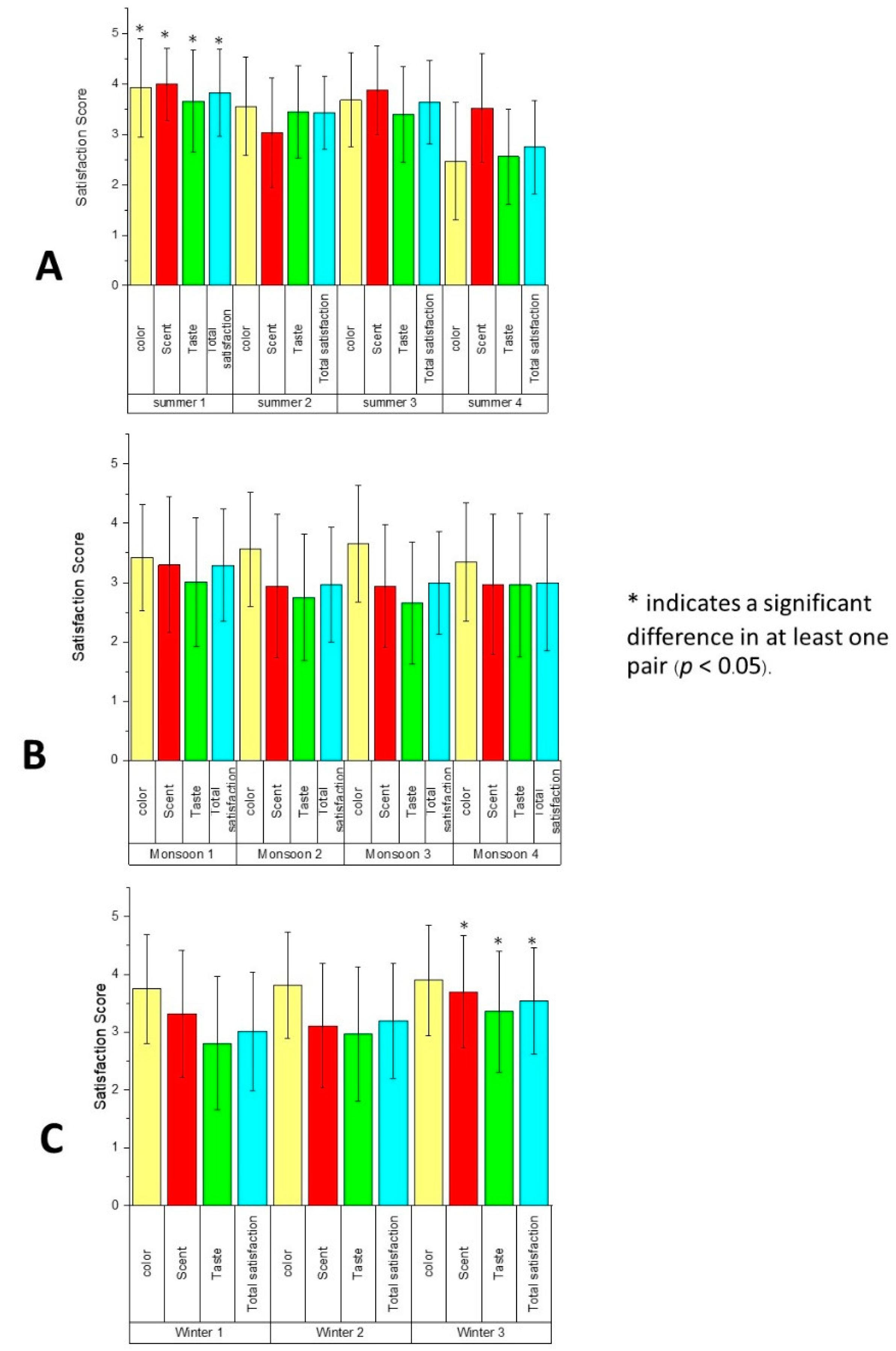1. Introduction
Herbal medicines have historically been important to human life and health. Phytochemicals are present in virtually all of the leaves, flowers, fruits, barks, roots and rhizomes that are commonly consumed as food and beverages. Excessive free radicals can cause oxidative stress, leading to various chronic and degenerative diseases in humans, such as heart disease, strokes, Alzheimer’s disease and cancer [
1,
2]. Phytochemicals—especially phenolics, carotenoids and curcuminoids—possess antioxidant properties [
3,
4,
5]. Antioxidants are possibly beneficial in promoting health or preventing age-related diseases [
6,
7]. Natural antioxidant compositions are usually found in a normal diet. Regularly consuming a wide variety of plants and spices is better for health than taking an antioxidant supplement. The word “tea” commonly refers to an infusion of
Camellia sinensis cured leaves and is an aromatic beverage that is consumed daily worldwide. If other herbs are used instead of
C.
sinensis, the beverage is called “herbal tea”.
Herbal infusion beverages, including herbal teas, are common worldwide. They spread from the east to the west hundreds of years ago. An infusion or decoction method is commonly used to extract bioactive compounds from the leaves. Phenolics are the most common phytochemical found in herbal teas and show health-promoting properties as they may be anti-microbacterial [
8], anti-carcinogenic [
9,
10], and antioxidative [
8]. Herbal teas are common remedies in folk medicine. For example, ginger tea (
Zingiber officinale), acquired from a fresh-cut rhizome, is used to relieve flatulence [
11]. The specific health properties of each herbal tea are dependent on the main component of the recipe. Herbal teas usually consist of more than one type of herb because the taste of a single herb may be unpleasant. The secondary components (present in smaller amounts than the main component) act as flavoring or coloring agents.
Proponents of Thai traditional and folk medicines believe that the human body is composed of four essential elements, including fire, water, wind and earth [
10]. These elements represent the body’s heat (fire), liquids (water), gas and air (wind) and flesh and bones (earth). Any imbalance of these body elements may result in a deficit, an excess or a disability, causing illness. For example, an excess of the fire element may increase body temperature, resulting in a fever. Additionally, the surrounding environment, such as the weather and seasons, can also influence the elements and may cause an imbalance. For example, cold winter weather could cause a deficit in the fire element, resulting in constipation and dyspepsia. Therefore, Thai traditional medicine bases its diagnoses on the balance of these four elements and prescribes herbs as treatments [
10]. The prescription of herbal teas is one of the approaches that Thai traditional and folk medicine practitioners use to treat their patients.
An enormous number of Thai herbal teas are available in Thai markets. The objective of this study was to formulate herbal teas according to Thai traditional medicine concepts to balance body elements during each Thai season (summer, monsoon and winter). The antioxidant properties of the teas were then evaluated, and healthy volunteers were asked about their satisfaction levels. This study demonstrated that Thai traditional herbal teas are good choices for people looking for health-promoting beverages.
2. Materials and Methods
2.1. Materials
Folin–Ciocalteu reagent, 2,2-Diphenyl-1-picrylhydrazyl (DPPH), 2,2’-Azinobis-3-ethylbenzothiazoline-6-sulphonic acid (ABTS), 3,4,5-Trihydroxybenzoic acid (Gallic acid) and 6-Hydroxy-2,5,7,8-tetramethylchromane-2-carboxylic acid (Trolox) were purchased from Sigma-Aldrich (St. Louis, MO, USA). Absolute ethanol, potassium persulfate and sodium carbonate were obtained from RCI Lab Scan (Bangkok, Thailand). Calcium hypochlorite was purchased from Union Science (Chiang Mai, Thailand). Chrysanthemum indicum (L.), Stevia rebaudiana (Bertoni), Morus alba (L.) and Ananas comosus were obtained from the Academic Service and Technology Transfer Center, Faculty of Agriculture, Chiang Mai University. Zingiber officinale, Cymbopogon citratus (DC.) Stapf, Mentha cordifolia Opiz. and Passiflora edulis Sims were purchased from JJ Market (Chiang Mai, Thailand). Green tea was purchased from Rimping superstore (Chiang Mai, Thailand). Pandanus amaryllifolius Roxb. and Zanthoxylum limonella Alston was obtained from the botanical garden at the Faculty of Pharmacy, Chiang Mai University (Chiang Mai, Thailand). Cinnamomum verum was purchased from the E.A.R. drug store, Warorot market (Chiang Mai, Thailand).
2.2. Antioxidation Assay Methods
2.2.1. Radical Scavenging Assay (DPPH)
The antioxidant activity of a DPPH (2,2-diphehyl-1-picrylhydrazyl) radical scavenging assay was investigated following a method described by Kodama et al. [
3]. A solution of DPPH radical was prepared in ethanol and measured at the wavelength 517 nm (absorbance ≤ 1.00 ± 0.02). Next, triplicates of the different sample concentrations (50 μL) were transferred into 96-well micro titer plates. Then, a DPPH radical solution was added to each well, except for one blank, shaken, then left in the dark at room temperature (30 min). After that, the absorbance (517 nm) was measured, and the percentage of inhibition as compared to the antioxidant standard was calculated,
where A
test is the absorbance of a free-radical solution and solvent, and A
Blank is the absorbance of solvent which replaces the free-radical solution. A
s-test is the absorbance antioxidant standard (Trolox or Gallic acid) with a free-radical solution, and A
s-Blank is the absorbance antioxidant standard with solvent. The result was compared to the antioxidant standard and interpreted in terms of the Trolox equivalence antioxidant capacity value (TEAC mg/150 mL) or the Gallic acid equivalent value (GAE mg/150 mL).
2.2.2. Radical Cation Decolorization Assay (ABTS)
The ABTS (2,2’-azinobis(3-ethylbenzthiazoline-sulphonic acid)) radical scavenging assay was tested using a method modified from Kodama et al. [
3]. The ABTS radical solution was prepared in a 2:1 ratio by using an ABTS radical solution in water (7 mM) and a potassium persulfate solution (2.45 mM). The mixture was stored in the dark at room temperature for 16–18 h. Next, the solution was diluted with ethanol, and the absorbance was measured at a wavelength of 734 nm (absorbance = 0.70 − 0.90 ± 0.05) before use. Then, 20 μL of the different sample concentrations were added to test tubes and mixed with 80 μL of ethanol including 2 mL of ABTS radical solution, and the absorbance was detected (734 nm). The percentage of inhibition was calculated and compared to the Trolox standard using the same formula as above. The ABTS experiments were done in triplicate.
2.2.3. The Folin–Ciocalteu Assay
A Folin–Ciocalteu assay was tested by a method modified from Al-Obaidi et al. [
12]. Fifteen microliters of sample solution and 250 μL of 2% sodium carbonate were mixed with 15 μL of 50% Folin–Ciocalteu reagent in a 96-well micro titer plate, then set aside in the dark at room temperature for 30 min. Finally, the absorbance was measured at wavelength 765 nm (The SPECTROstar
® Nano, BMG LABTECH GmbH, Ortenberg, Germany). The linear equation of Gallic acid standard was compared and interpreted in terms of Gallic acid equivalence antioxidant capacity value (GAE mg/150 mL). The Folin-Ciocalteu assay experiments were done in triplicate.
2.2.4. Statistical of Antioxidant Properties
One-way ANOVA was used to assess the mean differences between Thai traditional tea recipes in DPPH, ABTS and Folin–Ciocalteu assays. The level of significance is p < 0.05. The Tukey HSD post hoc test was used to identify the specific differences between Thai traditional tea recipes. All statistical results were analyzed by SPSS version 17.0 (IBM, New York, NY, USA). Results included means with standard deviations.
2.3. Herbal Tea Preparations
Herbs were cleaned by soaking them in a 50–100 mg/L calcium hypochlorite solution and then washing with a 25 mg/L calcium hypochlorite solution. They were then chopped into small pieces and dried in a hot air oven at 45–50 °C until the moisture content was less than 10%
w/
w. The dried herbs were milled. Herbal power size was controlled between 0.84 to 0.25 mm through sieving. Thai traditional herbal teas were prepared in three variations based on the Thai seasons (summer, monsoon and winter). Ingredients and weights were chosen, and the dried herbs were blended (
Table S1). The tea powder was put into paper tea bags and sealed with a heat sealer.
Morus alba L. was included in all beverage recipes because of its high antioxidant capacity [
13]. Several studies have shown that phenolics contained in mulberry leaves may have positive effects on human health [
14].
2.4. Satisfaction Test
A satisfaction questionnaire was given to 30 healthy volunteers between 18 and 30 years old. Authorization had been previously obtained from the Ethical Review Committee, Faculty of Pharmacy, Chiang Mai University (No.03/2017). The volunteers received 11 freshly prepared cups (approximately 220 mL) of herbal teas in tea bags that had been infused in hot water (95 °C) for 5 min. After sampling each herbal tea, they scored the teas in four categories including color, scent, taste and total satisfaction, using a scale of 5 = most positive and 1 = least positive. Each volunteer had to rate 11 tea recipes. The descriptive analyses include reports of means and standard deviations. A one-way repeated measurement ANOVA statistical test (SPSS 17, IBM, New York, NY, USA) was used to analyze the volunteers’ questionnaire scores for each season with a significance level of p < 0.05. If significance was found, a Bonferroni multiple comparison was used to allocate the specific differences.
4. Discussion
Seasonal weather affects the elements of the body. For example, hot summer weather may result in excess body heat. The cool and wet conditions of the monsoon season may cause an excess of the wind element and a deficiency in the fire element. Misty and cold weather in the winter may unbalance the water element, causing increased phlegm and eventually leading to development of a cold. Therefore, this study used beverage recipes containing herbs with the potential to balance the body’s elements. For example,
A.
marmelos and
P. amaryllifolius were used for refreshment and to relieve an excessive fire element.
Z.
officinale was used to compensate for fire element deficiencies.
P. edulis Sims. was used to treat an excessive water element. In addition to balancing body elements, these herbal beverages also had antioxidative properties. Therefore, this study looked at the antioxidant properties and the satisfaction scores given by the volunteers. A total of 11 herbal tea recipes, formulated based on the concept of balancing body elements in each season in Thailand (summer, monsoon and winter), were evaluated. The summer tea recipe 1 showed the most effective antioxidant activity based on all measurement methods and was comparable to green tea. This was likely the result of including
S. rebaudiana and
M. alba in the recipe [
13,
15,
16]. However, the antioxidant activity of the monsoon and winter tea recipes were inconclusive based on a DPPH assay, an ABTS assay and the total phenolic content. Inconsistencies in the antioxidant activities of the monsoon and winter tea recipes might be explained by factors such as the quantity of the various bioactive components, variations in the sources of herbal tea materials and the different amounts of herbal powder in each tea bag based on their density. In addition, when all herbal tea recipes were evaluated, the summer tea recipe 1 showed the highest level of volunteer satisfaction in all categories (color, scent, taste and total satisfaction). However, there were no correlations between antioxidant activity and volunteer satisfaction in the monsoon and winter tea recipes. The summer tea recipe 1 is a beverage that balances the body elements in summer and contains high antioxidant properties that are comparable to green tea. In addition, it was viewed favorably by a wide age range of consumers, from teenagers to middle-aged.
5. Conclusions
This study evaluated antioxidant activity and satisfaction levels for 11 Thai traditional teas that were formulated based on Thai seasons (summer, monsoon, and winter). Evaluations of DPPH, ABTS and total phenolic content were performed to examine the antioxidant properties of these herbal teas. Among the summer tea recipes, all tests of antioxidant activity concluded that the summer tea recipe 1 had the most antioxidant activity. However, tests of the monsoon and winter tea recipes showed different antioxidant levels depending on the assay method used. The volunteer satisfaction tests showed that recipe 1 was the most satisfying tea of the summer recipes, a statistically significant finding. Among the winter recipes, the winter tea recipe 1 was the most satisfying in all categories. These results, except for scent, were found to be statistically significant. Although the monsoon tea recipe 1 was the most satisfying in the monsoon group, this result was statistically insignificant. Herbal teas formulated based on the concepts of Thai traditional medicine have favorable antioxidant properties and are pleasing to consumers. Therefore, they are very promising alternatives to health beverages currently available, and this potential market could add value to the native herbs of Thailand.








